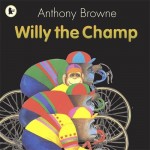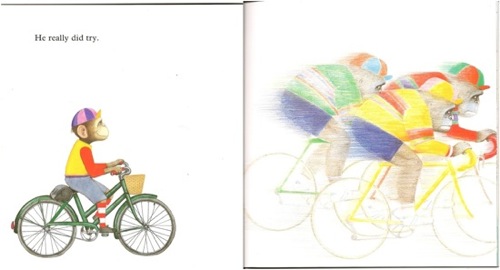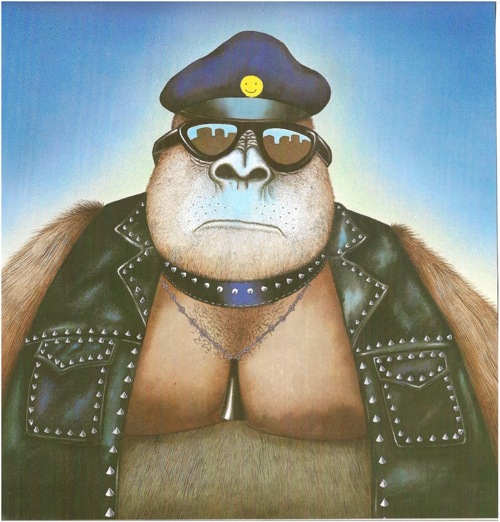by Prisca Martens, Towson University, Towson, MD
In last week’s blog we reflected on the various modes or semiotic systems through which our culture communicates meaning. These include visual (i.e., art, moving images), linguistic (i.e., language), auditory (i.e., sound, music), gestural (i.e., movement, dance), and spatial (i.e., layout, design). Picturebooks are multimodal, drawing on the linguistic, visual, spatial, and gestural systems. Schools and society, though, tend to emphasize the written text for constructing meaning at the expense of the others.
My colleagues and I are in the second year of a three year study exploring how, in picturebooks, learning to read meanings through a variety of modes relates to beginning readers’ reading development. We worked with 37 first graders in two classrooms last year. At the beginning and end of the year we asked the children to read a picturebook and retell it and then respond to questions about the illustrations without the book in front of them.
 Before the study began in the fall, the children read I Love My New Toy (Willems, 2008). One question we asked was “Did you notice anything about the illustrations or the way the illustrator draws/paints?” The children’s comments about the illustrations primarily related to surface features they saw, including naming colors they remembered, noting that the story used speech bubbles, and sharing how the illustrations were created (i.e., “He used paint”; “He stayed in the lines”).
Before the study began in the fall, the children read I Love My New Toy (Willems, 2008). One question we asked was “Did you notice anything about the illustrations or the way the illustrator draws/paints?” The children’s comments about the illustrations primarily related to surface features they saw, including naming colors they remembered, noting that the story used speech bubbles, and sharing how the illustrations were created (i.e., “He used paint”; “He stayed in the lines”).
 At the end of first grade the children read Willy the Champ (Browne, 2008), the story of a chimp who isn’t good at anything but defeats a big bully at the end and becomes a hero. With the book closed, the children’s comments about the illustrations after reading were much more in-depth and revealed that they were reading meanings in the illustrations in addition to the written text. One page, for example, shows Willy in a bike race that he is losing as the other bikers speed quickly ahead of him.
At the end of first grade the children read Willy the Champ (Browne, 2008), the story of a chimp who isn’t good at anything but defeats a big bully at the end and becomes a hero. With the book closed, the children’s comments about the illustrations after reading were much more in-depth and revealed that they were reading meanings in the illustrations in addition to the written text. One page, for example, shows Willy in a bike race that he is losing as the other bikers speed quickly ahead of him.
All the written text says is, “He really did try.” Children’s comments on this page included:
- In one of the picture when they did the biking he made all the guys blurry because they were fast but Willy was crystal clear because he wasn’t going fast.
- When they were riding the bikes they looked smeary. Willy was slow so he didn’t look smeary.
Many children also commented on what they noticed about the bully, who was wearing a black leather jacket with spikes.
Their comments included:
- Buster was a mean bad guy. His clothes were black and spiky. Black is the dark color of evil and spikes are pointy and that is evil.
- He used curvy lines for Willy because he’s good and for Buster he used pointy lines because he was mean.
Not surprisingly, the children’s retelling scores were substantially higher for Willy the Champ. We know, though, that there are multiple possible reasons for this. What the children’s comments do reveal, however, is that these first grade readers noticed and read meanings in multiple sign systems and that enriched their understandings. Next week we’ll look at some of the curricular experiences the children had that supported their growth.
Browne, A. (2008). Willy the champ. Walker Books.
Willems, M. (2008). I love my new toy. Hyperion.
Journey through Worlds of Words during our open reading hours: Monday-Friday, 9 a.m. to 5 p.m. and Saturday, 9 a.m. to 1 p.m. To view our complete offerings of WOW Currents, please visit archival stream.
- Themes: Prisca Martens
- Descriptors: Books & Resources, Debates & Trends, Student Connections, WOW Currents



This powerful novel focuses on trafficking in sexual slavery. Some passages are explicit in portraying the pain and abuse that Lakshmi suffers as she is forced into prostitution. College students in my class, A Global View through Children’s Literature, wrote that Sold changed their thinking and made them want to take action against such trafficking.
Marilyn Carpenter
This was a hard book to read, but in terms of writing quality, storyline and emotional impact it is one of the best young adult novels that I’ve read.